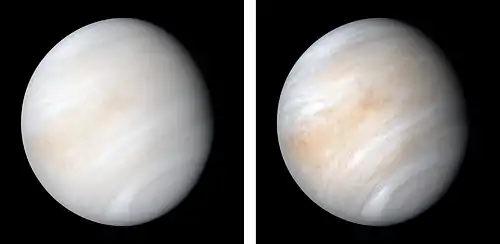WD 1856+534
WD 1856+534 is a white dwarf located in the constellation of Draco. At a distance of about 25 parsecs (80 ly) from Earth, it is the outer component of a visual triple star system consisting of an inner pair of red dwarf stars. The white dwarf displays a featureless absorption spectrum, lacking strong optical absorption or emission features in its atmosphere. It has an effective temperature of 4,700 K (4,430 °C; 8,000 °F), corresponding to an age of approximately 5.8 billion years.[2] WD 1856+534 is approximately half as massive as the Sun, while its radius is much smaller, being 40% larger than Earth.[3]
 Artist's impression of WD 1856+534 and its planet. | |
| Observation data Epoch J2000 Equinox J2000 | |
|---|---|
| Constellation | Draco |
| Right ascension | 18h 57m 39.34s[1] |
| Declination | +53° 30′ 33.30″[1] |
| Characteristics | |
| Evolutionary stage | white dwarf |
| Spectral type | DC(11?)[1] |
| Apparent magnitude (J) | 15.677±0.055[1] |
| Apparent magnitude (H) | 15.429±0.094[1] |
| Apparent magnitude (K) | 15.548±0.186[1] |
| Astrometry | |
| Proper motion (μ) | RA: −240.759±0.148[1] mas/yr Dec.: −52.514±0.143[1] mas/yr |
| Parallax (π) | 40.3983±0.0705[1] mas |
| Distance | 80.737±0.144 ly (24.754±0.044[2] pc) |
| Details[2] | |
| Mass | 0.518±0.055 M☉ |
| Radius | 0.01310±0.00054 R☉ |
| Surface gravity (log g) | 7.915±0.030 cgs |
| Temperature | 4710±60 K |
| Metallicity [Fe/H] | <−8.8 dex |
| Age | 5.85±0.5 Gyr |
| Position (relative to G 229-20)[2] | |
| Angular distance | ~43″ |
| Observed separation (projected) | 1030+130 −55 AU [2] |
| Other designations | |
| Database references | |
| SIMBAD | data |
| Exoplanet Archive | data |
| Extrasolar Planets Encyclopaedia | data |
Planetary system
The white dwarf is known to host one exoplanet, WD 1856b, in orbit around it. The exoplanet was detected through the transit method by the Transiting Exoplanet Survey Satellite (TESS) between July and August 2019. An analysis of the transit data in 2020 revealed that it is a Jupiter-like giant planet with a radius over ten times that of Earth's, and orbits its host star closely at a distance of 0.02 astronomical units (AU), with an orbital period 60 times shorter than that of Mercury around the Sun. The unexpectedly close distance of the exoplanet to the white dwarf implies that it must have migrated inward after its host star evolved from a red giant to a white dwarf, otherwise it would have been engulfed by its star.[2] This migration may be related to the fact that WD 1856+534 belongs to a hierarchical triple-star system: the white dwarf and its planet are gravitationally bound to a distant companion, G 229-20, which itself is a binary system of two red dwarf stars.[2] Gravitational interactions with the companion stars may have triggered the planet's migration through the Lidov–Kozai mechanism[4][5][6] in a manner similar to some hot Jupiters. An alternative hypothesis is that the planet instead has survived a common envelope phase.[7] In the latter scenario, other planets engulfed before may have contributed to the expulsion of the stellar envelope.[8]
| Companion (in order from star) |
Mass | Semimajor axis (AU) |
Orbital period (days) |
Eccentricity | Inclination | Radius |
|---|---|---|---|---|---|---|
| WD 1856+534 b | <13.8 MJ | 0.0204±0.0012 | 1.4079405±0.0000011 | ~0 | 88.778±0.059° | 10.4±1.0 R⊕ |
See also
- WD 1145+017, a white dwarf with a transiting disrupted planetary-mass object
- WD J0914+1914, a white dwarf a disk of debris originating from a possible giant planet
- ZTF J0139+5245, another white dwarf with a disk of debris from a disrupted planetary-mass object
References
- "LP 141-14 -- White Dwarf". SIMBAD. Université de Strasbourg. Retrieved 20 September 2020.
- Vanderburg, Andrew; Rappaport, Saul A.; Xu, Siyi; Crossfield, Ian J. M.; Becker, Juliette C.; Gary, Bruce; et al. (September 2020). "A giant planet candidate transiting a white dwarf". Nature. 585 (7825): 363–367. arXiv:2009.07282. Bibcode:2020arXiv200907282V. doi:10.1038/s41586-020-2713-y. PMID 32939071. S2CID 221738865.
- Potter, Steve (16 September 2020). "NASA Missions Spy First Possible 'Survivor' Planet Hugging White Dwarf Star". NASA. 20-086. Retrieved 20 September 2020.
- Muñoz, Diego J.; Petrovich, Cristobal (2020-11-19). "Kozai Migration Naturally Explains the White Dwarf Planet WD1856b". The Astrophysical Journal. 904 (1): L3. arXiv:2010.04724. Bibcode:2020ApJ...904L...3M. doi:10.3847/2041-8213/abc564. ISSN 2041-8213. S2CID 222290559.
- O'Connor, Christopher E.; Liu, Bin; Lai, Dong (2020-11-30). "Enhanced Lidov-Kozai migration and the formation of the transiting giant planet WD1856+534b". Monthly Notices of the Royal Astronomical Society: staa3723. arXiv:2010.04163. doi:10.1093/mnras/staa3723. ISSN 0035-8711. S2CID 222272242.
- Stephan, Alexander P.; Naoz, Smadar; Gaudi, B. Scott (2020-10-20). "Giant Planets, Tiny Stars: Producing Short-Period Planets around White Dwarfs with the Eccentric Kozai-Lidov Mechanism". arXiv:2010.10534 [astro-ph.EP].
- Lagos, F.; Schreiber, M. R.; Zorotovic, M.; Gänsicke, B. T.; Ronco, M. P.; Hamers, Adrian S. (2021), "WD 1856 b: a close giant planet around a white dwarf that could have survived a common-envelope phase", Monthly Notices of the Royal Astronomical Society, 501 (1): 676–682, arXiv:2010.09747, Bibcode:2021MNRAS.501..676L, doi:10.1093/mnras/staa3703, S2CID 224802868
- Chamandy, Luke; Blackman, Eric G.; Nordhaus, Jason; Wilson, Emily (2020), Multiple common envelope events from successive planetary companions, arXiv:2011.11106
External links
- NASA Missions Spy First Possible ‘Survivor’ Planet Hugging White Dwarf Star, Sean Potter, NASA, 16 September 2020
- Planet discovered transiting a dead star, Steven Parsons, Nature News and Views, 16 September 2020


_on_Jul_14_2020_aligned_to_stars.jpg.webp)